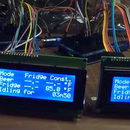Introduction: Cheap and Easy Lab Agitator / Shaker (Great for PCBs Too!)
EDIT 4/16/15: I switched power supplies to a 5 Volt, 1/2 Amp with a USB adapter. This slows down the agitation motion to a more tolerable level and allows me to plug it into my PC to power it as well! See updated video above.
I am a die hard home brewer. As such, I have also become quite the nerd about yeast. It's just something about those little cells that turn liquid sugar into beer that has me enthralled. Therefore, I found it only fitting to build a small yeast laboratory in a spare closet in my home.
I have pretty much everything I need in there, microscope, magnetic stir plates, pressure cooker for sterilization, fridge for storing samples, culture plates, slants, you get the idea...
The one thing I didn't have was a way to shake up very small cultures of yeast while I am building them into a volume that I can use to make beer with. Magnetic stir plates are great, but they don't work as well for volumes in the 5 mL range and the tubes I use to culture this small volume won't work on a stir plate.
I needed an orbital lab shaker. 10 minutes later on Ebay, I decided that I didn't need it that much. ($1500??!!)
But I still wanted to avoid needing to visit the closet laboratory every few hours to shake up those tubes.
Then I discovered that several people have used old CD-ROM drives to agitate their solutions for etching PCBs (Printed Circuit Boards) and I had to check that out.
They are seriously awesome, but here's the deal: I don't want to buy an Arduino, figure all that out (After all, I'm a Raspberry Pi kinda guy..) and spend another $40 on that stuff. I wanted to do this with things I already hoard, much to my wife's dismay.
So, here is a non-digital, totally automated, mechanical agitator that you can make at home and with stuff you already probably have. (Especially if you frequent this site.)
Step 1: Gather Your Parts.
For this project you will need the following:
- 1 Old CD-ROM drive with enclosure
- Various wire rated for at least 12 V at 1 Amp (Different colors make for easier identification.)
- 1 SPST (Single Pole-Single Throw) I used a toggle but any non-momentary switch should do.
- 1 DPDT (Double Pole-Double Throw) This needs to be a toggle switch for our design and should take very little force to throw the switch. (No "Center Off" switches.)
- "Wall Wart" DC power supply. I used a 5 VDC .5 Amp supply with a USB adapter and cut the end off. Other voltages should work too but will affect the speed of the motor. (Use at your own risk people!)
- Soldering iron and solder.
- Small Phillips and flat head screwdrivers to disassemble the CD-ROM drive
- Hot glue gun and glue or epoxy
- Various salvage plastic pieces for tray and supports. (Check the recycling bin or your kids toy closet!)
- Small drill bit to mount switches and drill
The only thing I didn't have were the switches. I found them both at Radio Shack for $8.50 total.
The SPST switch will have 2 terminals. The DPDT switch will have 6 terminals and SHOULD NOT have a "Center Off" feature.
Step 2: Take Apart the CD-ROM Drive
This is actually more straightforward than it seems. These things are incredibly easy to take apart. Usually just 4 screws hold the case together and then the electronic components have small screws or are held in with plastic clips that are a part of the housing.
What you need to end up with is the outer box housing and the tray and drive assembly with just the tray motor and gears remaining. Try to not force or break anything apart in case you find you need it later.
With my particular drive I was able to flip the tray over and screw it back to the housing as a stand, I suspect many other drives will be the same. I also need to de-solder a small PCB from the tray motor but it was simple to do and was actually not entirely necessary.
Step 3: Wiring and How It Works...
In this project we will be turning the motor in one direction and then will need to have it switch directions to rock back and forth (Open and close). We can use a complicated integrated circuit for this or just do it mechanically. (Which is what I did...)
Basically the DC motor runs in one direction depending on the polarity. (Flow from positive to negative.) Switch the polarity and the motor turns in the opposite direction. So if we can force the tray to flip a switch as it opens and closes that will subsequently switch the polarity, it will run on an infinite loop. Until you turn off the power anyway...
We will position the DPDT toggle so the tray will "run into" it during every open and close cycle. But more one that later.
So lets wire the most important piece first...
Step 4: Wire the DPDT Switch
Basically we need to make sure that every time the switch is thrown, that the polarity switches. (Positive and negative sides of the circuit flip to the opposite direction.)
Here's how the terminals should be wired on the DPDT switch when looking down at the terminals from above:
- The two red leads shown will go out to the motor and one lead should attach to each of the terminals on the left side.
- The green and blue jumpers shown attach to the same terminals as the red leads and then "criss-cross" to the far right terminals. This effectively switches the direction of the circuit when the toggle is thrown to that side.
- The center terminals are for your power in. We'll leave those empty for now.
Solder everything together and leave plenty of wire for your leads to reach the motor, you can cut them short later after you have mounted your switch in it's final position.
Step 5: Mount and Wire the SPST
- Make sure the power switch will be mounted out of the way of the moving tray and that it's accessible.
- Drill a small hole for the size of the switch you are using and mount it with the provided nut.
- Attach one lead from your DC power supply to one terminal on the switch.
- Solder.
- Attach a longer wire (Long enough to reach the DPDT switch.) to the other terminal
- Solder.
Step 6: Wire Power to DPDT Switch
- Attach the free lead directly from the AC adapter to one of the CENTER terminals on the DPDT switch.
- Solder.
- Attach the free lead coming from the SPST "Power" switch to the free CENTER terminal on the DPDT switch.
- Solder.
Step 7: Mount Your DPDT Switch
This is the most important part.
The DPDT switch has to be placed somewhere that the tray's open and close action will activate the toggle back and forth. Effectively switching the polarity of your circuit.
I found a great spot on my drive that already had a small hole that the switch could mount into. You need to think about also adding a piece of plastic to the tray that will serve to flip the switch as well. In the photos, you can see I added some scrap plastic pieces (White) to actuate the switch in a specific tray open/close position.
Step 8: Wire Your Motor
Take the two remaining leads (Red on my images.) from the DPST switch and solder them to the 2 terminals on the motor. It doesn't matter which lead goes on which terminal. If for some reason the tray ends up moving in the opposite direction that it needs to initially and gets stuck, you just need to flip these two wires. (Remember that for later!)
Now you're done with the hard stuff and can get creative with your tray set up!
Check the video for what should happen when you plug it in and flip on the power switch! Be sure to pay close attention to the switch flipping action.
Step 9: Build a Platform and Tray However You Would Like!
You'll see that I used a few plastic building blocks, hot glue, the spare metal cover from the CD-ROM, and some shelf liner mat for a non-slip surface on the top.
You may also consider the following:
- Adding weight to the base to keep it from flying off the table every few minutes.
- Non-skid feet for the base.
- Tape down the wires inside the case so they cannot be yanked out. I used hot glue.
- This motor was probably not rated for continuous duty, so it's anyone's guess how long it will last.
- Maybe use a potentiometer inline to slow the motor?
All in all, have fun and be creative!
I hope you enjoyed this Instructable! Please leave a comment or ask any questions below!

Participated in the
Move It

Participated in the
Automation Contest













